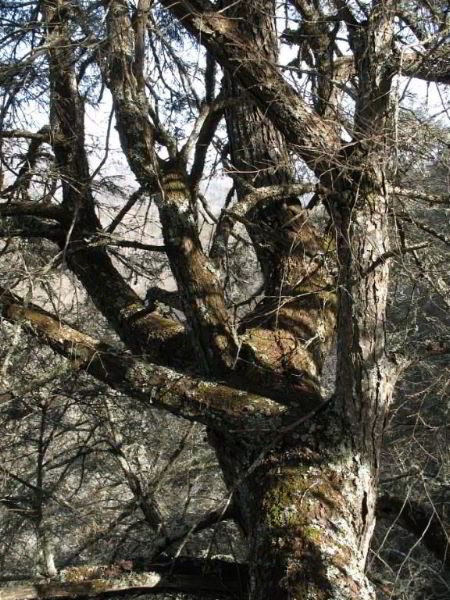Will Blozan (November 1, 2007) writes Usis Hemlock Update
Fellow climber Jason Childs and I climbed in the Usis hemlock this
weekend and are sad to report that it has died. The Usis tree was the
tallest known eastern hemlock at 173.1' tall and the fourth largest
documented with 1533 cubic feet of wood. It also had the largest volume
of reiterations and one
of the most complex canopies I have had the honor to traverse.
Will Blozan (February 16, 2008) writes: Usis Hemlock Climb The climb of the Usis hemlock in Cataloochee went as planned yesterday (2/15/2007). We entered the valley with thick hoarfrost covering the ridges and a light snow falling in the brisk 9 degree air. Jess Riddle, Jason Childs, Josh Kelley and I comprised the team. As some of you may recall, the name "Usis" is a Cherokee word for antler. This name was chosen due to the huge reiterated limbs composing a significant portion of the crown. After being immersed in the canopy for 6 hours I firmly believe it is a fitting name. ...To me, the Usis Hemlock summarizes, in one tree, the superlatives of the species, Tsuga canadensis. It is an ancient tree with extreme character, height and mass. It grows in the wild, rich slopes of the southern Appalachian treasure of Great Smoky Mountains National Park. I feel fortunate to be in a situation to document trees such as the Usis Hemlock, and attempting to preserve for future generations the grandest examples of a regionally vanishing tree. For those holding your breath, the Usis Tree is in massive decline from hemlock woolly adelgid, and is unlikely to respond to conventional treatments- at least promptly enough to recover to its former glory. Large sections of the crown are already dead and very few needles remain. However, it has not yet produced a second flush of twigs yet, so provided enough buds survived the first HWA attack and treatments are effective, it may survive. It is hard to imagine such a massive tree succumbing to those little sucking bastards. What an utterly undignified death.
|
|||||||


 Con FUSEion
Con FUSEion